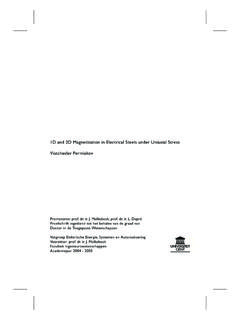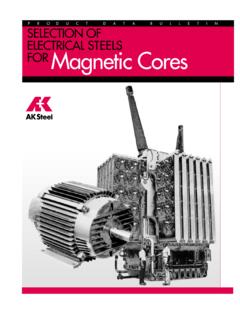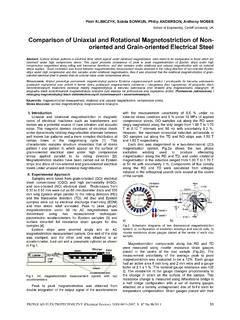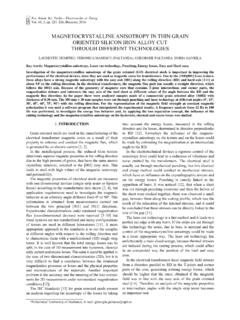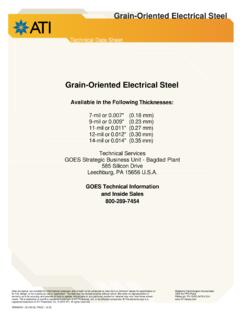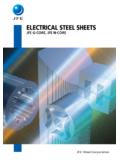Transcription of E. Below are Allegheny Technologies Incorporated’s ...
1 Bagdad Plant Raymond J. Polinski 585 Silicon Drive General Manager Leechburg, PA 15656 grain - oriented electrical steel e-mail: E. Below are Allegheny Technologies Incorporated s comments on certain issues in which the DOE sought comment. 17. DOE seeks comment on nanotechnology composites and their potential for use in distribution transformers. Soft magnetic and amorphous particles with excellent magnetic properties can be and are currently produced, but the insulating matrix required to eliminate short-circuit paths dissipate power at the operating frequencies for power distribution transformers (50/60 Hz). Such transformer cores are currently only used for high-frequency applications where significant excitation of the insulating matrix does not occur. 18. DOE requests comment on its materials prices for both 2010 and 2011 cases.
2 Materials prices as cited in the NOPR and TSD for the proposed ruling The 2010 grain - oriented electrical steel pricing as shown in the table above (screenshot from the TSD, page 5-42) is generally representative of the domestic market. The remainder of the price information (amorphous core prices, copper, aluminum, etc.) is outside of the scope of the commenter s expertise. The prices used in the 2011 evaluation were significantly discounted versus 2010 for conventional grain - oriented electrical steels, while alternative grades (amorphous core materials and mechanically scribed high permeability electrical steel from Japan) were discounted by less than 10%. The market for distribution transformers, which is generally controlled by housing starts and new construction, did not change significantly year on year over the 2010-2011 time frame, and the available domestic supply of core steel also did not change significantly over that period.
3 As such, it is unclear as to why the prices for grain - oriented electrical steel were decreased by 20-30% (see Below ). As was stated by the grain - oriented electrical steel producers (ATI and AK steel ) as well as the grain - oriented electrical steel consumers (transformer company representatives) on the DOE committee, the 2011 grain - oriented electrical steel prices were understated by at least 15% (at a minimum it appears that the grain - oriented electrical steel raw material surcharges were not included in the 2011 price). As was stated throughout the DOE committee process, the relative price for alternate core materials tend to track each other. Thus if amorphous prices declined 8% in 2011 versus 2010 then the grain - oriented electrical steelM-2 and M-3 prices (direct substitutes for each other) would decline a similar percentage.
4 Table 18-2 Item and Description 2010 Price 2011 Price 2011 2010 Delta Percent Change M6 core steel $ $ $( ) -22% M5 core steel $ $ $( ) -20% M4 core steel $ $ $( ) -17% M3 core steel $ $ $( ) -31% M2 core steel $ $ $( ) -30% ZDMH core steel $ $ $( ) -7% SA1 finished core $ $ $( ) -8% It is notable that the price reduction for M-4, M-5 and M-6 is in the 20% range, while for M-2 and M-3 the reduction is greater at 30%. The reasoning behind this is unclear, as M2 and M3 are higher-end grades which are in more limited supply relative to M-4, M-5 and M-6, which are readily available from essentially all grain - oriented electrical steel producers. As such, they have held their value better in a market which is currently oversupplied with the lower-end grades. M-2 and M-3 conventional grain - oriented electrical steel are critical grades which can be used to produce high-efficiency, cost effective wound-core transformers, which are commonly used for the MVLT design lines.
5 The artificial discount in price for these two grades makes efficient transformers with grain - oriented electrical steel cores appear to be less expensive to produce than they actually are they are artificially discounted relative to amorphous-core transformers. This has significant implications for the location of the cross-over point in the Navigant model output. The cross-over point is the efficiency rating where a transformer from a given design line with a grain - oriented electrical steel core and a corresponding transformer with an amorphous core are priced identically. If the price of M-2 and M-3 are set artificially low relative to ZDMH and SA1, and all other material price inputs are kept the same (Table confirms this fact), then the cross-over point moves to higher efficiency levels for the design line in question.
6 Thus the DOE should not utilize the 2011 data when determining the efficiency levels. The use of the 2011 engineering analysis data in combination with the 2010 data along with the desire to scale DL 1 (single phase pad) and DL2 (single phase pole) results in the NOPR efficiency levels being higher than if only the 2010 data was utilized. The initial cross over points for SA1 and M-3 (which all groups agreed should dictate the proposed efficiency levels) for MVLT were calculated based on the 2010 Navigant analysis and confirmed via separate SA1 versus M-3 cost comparisons performed by H-volt and AK steel (listed in Table 18-2). Table 18-2 Design Line Efficiency Level Efficiency 01 EL 02 EL 0 (baseline) 03 EL 04 EL 05 EL NEMA, in an effort to enable a negotiated settlement, proposed increasing these levels to the values listed in Table 18-3, based on input from all the transformer members on the DOE rulemaking committee.
7 These are shown in the table Below . Table 18-3 Design Line Efficiency Level Efficiency 01 EL 1 02 EL 0 (baseline) 03 EL 1 04 EL 1 05 EL 1 The Navigant data sets for 2010 and 2011, which are available for download on the internet, were analyzed to determine the effect of 2011 pricing relative to 2010 pricing on the cross-over points for the MVLT superclass. The result is an increase of one-half to one full efficiency level (Table 18-4), with an M3 transformer placed at an artificial price disadvantage of 7-12% relative to an SA1 amorphous core transformer. The correct NOPR efficiencies in Table 18-4, based on the most recent release of Navigant data calculated with 2010 pricing, represents the M-3 and SA1 cross-over points. This ensures that these two core materials can compete on a cost-competitive basis, the projected LCC savings are achieved and adequate core steel supply is available.
8 Design Line 1 can actually be increased to , while Design line 2 needs to remain at the baseline level of Design Lines 3 and 5 should be slightly lowered while design 4 can remain unchanged. However, any increase in the NOPR efficiency levels for MVLT with the exception of Design Line 1 are not supported by the engineering analyses. For more detail, see the attached White Paper- Analysis of Cross-Over Points for grain - oriented electrical steel and Amorphous Ribbon for the MVLT Superclass. Table 18-4 Crossover Points NOPR efficiency M-3 cost disadvantage due to 2011 price scenario at NOPR efficiency Design Line 2010 prices 2011 prices 01 -$144 ( ) 02 Below -$104 ( ) 03 -$1,049 ( ) 04 -$604 ( ) 05 -$3,152 ( ) 19. DOE requests comment on the current and future availabilities of high-grade steels, particularly amorphous and mechanically-scribed steel in the United States.
9 Mechanically-scribed electrical steel is produced by one producer in Japan. Domestic availability is limited and domestic production is not anticipated in the near future. 21. DOE requests comment on its steel supply availability analysis, presented in appendix 3A of the TSD. The grain - oriented electrical steel market has historically been characterized by slow growth, excess global grain - oriented electrical steel capacity, and relatively low grain - oriented electrical steel profitability. This discouraged grain - oriented electrical steel capacity expansion and in fact some grain - oriented electrical steel producers idled higher cost grain - oriented electrical steel capacity in the 2002-2003 timeframe. The period of 2004-2007 was marked by growing undersupply due to the rapid electrification of emerging economies, primarily in Asia and India.
10 This led to a rapid increase in the market price for grain - oriented electrical steel . In response to the period of limited availability and subsequent market-driven elevated prices, significant expansion of grain - oriented electrical steel production has taken place. Several of the long-term producers have expanded capacity significantly, and several new producers have entered the market. Of the MMT of global grain - oriented electrical steel capacity cited in the report, approximately MMT (30%) has been added in the last five years. This has eliminated the problem of undersupply under normal market conditions, and has resulted in oversupply during the economic downturn. This rapid expansion in supply was not noted in the steel supply availability analysis. The analysis also neglects to note that in April 2010, the Chinese government imposed countervailing and anti-dumping duties on the two American grain - oriented electrical steel producers, effectively closing off one of the largest global export markets for domestically produced grain - oriented electrical steel .











